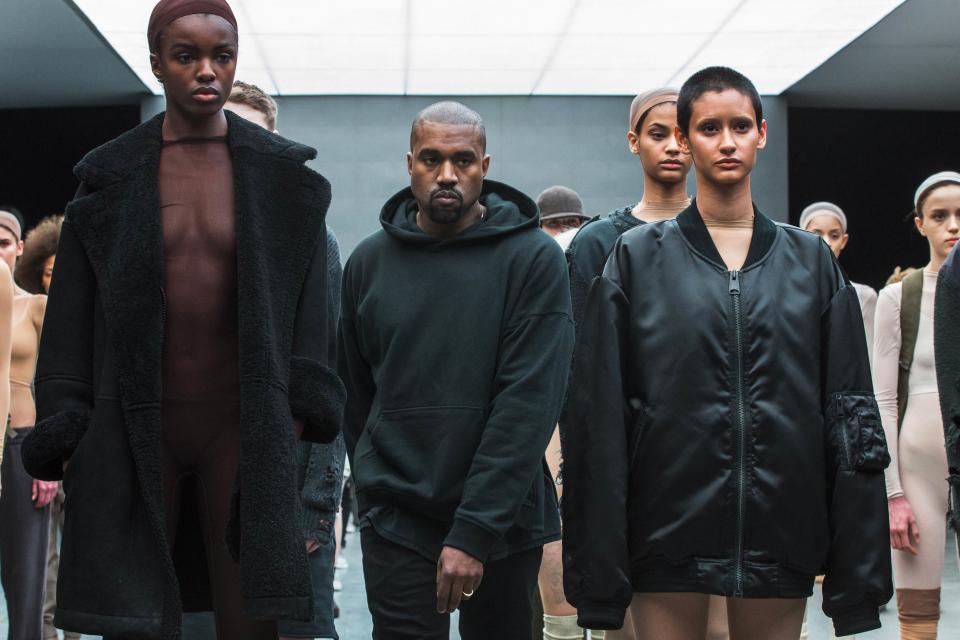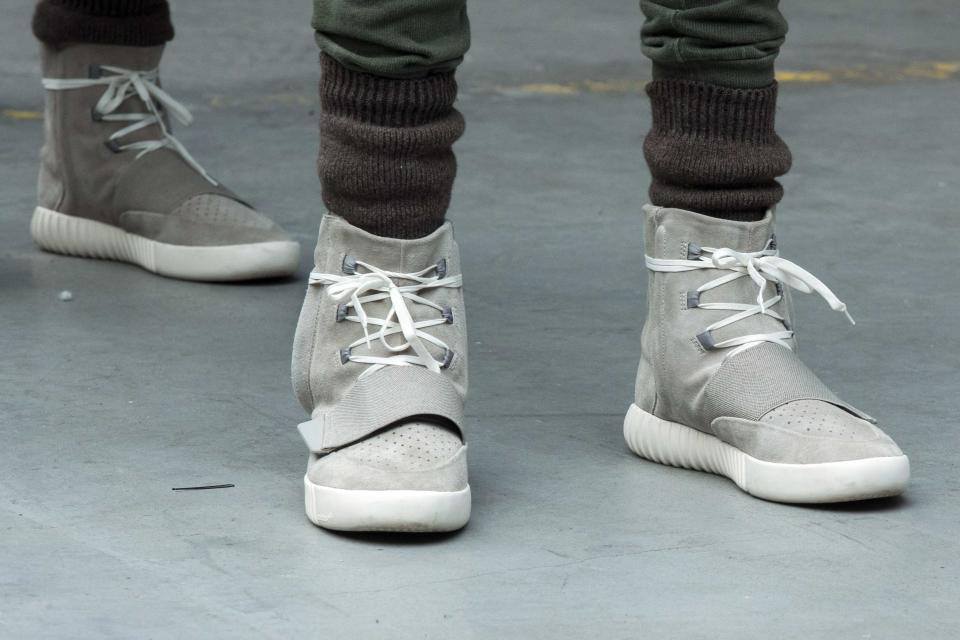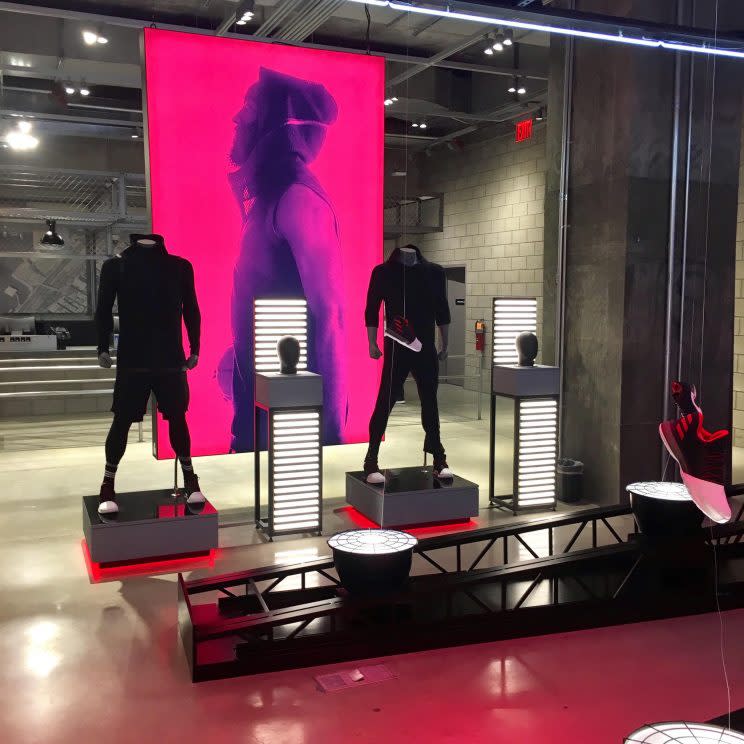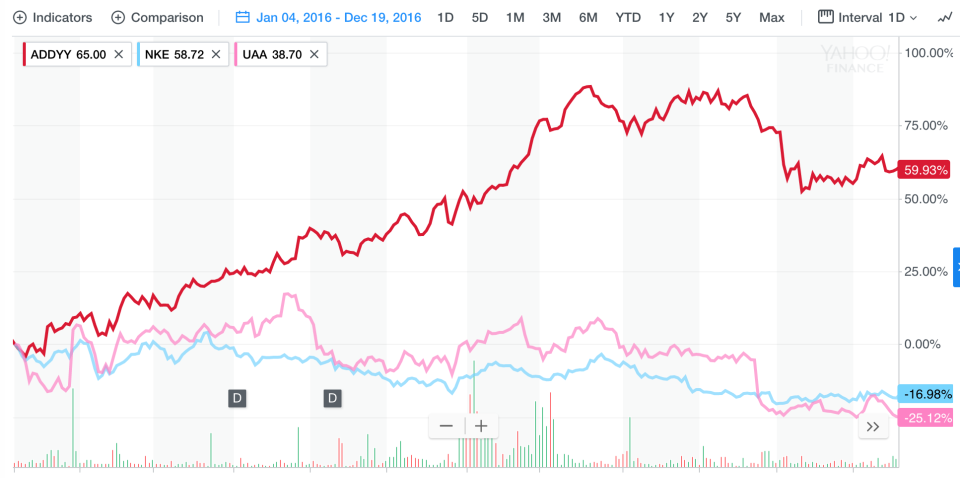Adidas is Yahoo Finance's 2016 Sports Business of the Year
Two years ago, German sportswear giant Adidas Group was sucking wind in America.
It had just been unseated as the No. 2 apparel brand in the US by Under Armour, practically a teenager (Kevin Plank founded the upstart brand in 1996) compared to 90-year-old Adidas. In footwear, it ceded No. 2 to Skechers, which had made great gains seemingly out of nowhere. Adidas lost US footwear market share every year from 2011 to 2015.
This year, it all changed. Adidas brand’s market share of US athletic footwear rose to 7.2% for this year through November, up from 4.3%, according to NPD Group. Nike’s share (without Jordan Brand) fell to 37.3%, down from 41% last year. Adidas has clawed back the No. 2 athletic footwear spot from Skechers.
In its third quarter, Adidas brand revenues rose 20% (on a currency-neutral basis), Reebok revenues grew 7% and even TaylorMade, the struggling golf-club maker Adidas Group is looking to sell off, rose 6%. The $19 billion-in-annual-sales, $32 billion-market-cap company saw double-digit sales growth in the third quarter in every market but Russia. In a December note, Canaccord Genuity Group observed “a trend shift” in sports apparel “that continues to favor Adidas and to which retailers are responding in kind.”
The sporting goods industry has faced brutal headwinds this year in the US, especially at the retail level. Brick-and-mortar sports chains like Sports Authority, Bob’s Stores, Eastern Mountain Sports, and Sports Chalet have all filed for bankruptcy. Even amidst this, Adidas has thrived. It has turned things around in America, where it struggled most. That starts with sneakers.

Sneakers and Kanye West
The US sneaker market has shifted, analysts say, toward a blending of performance (an industry term that refers to sneakers worn expressly for sports) and fashion. Adidas has been uniquely positioned to benefit from the trend. The brand has long been known in America for its street clothes (recall Run DMC singing “My Adidas” in the 1990s) but more recently was criticized for focusing too much on fashion (the division Adidas calls “Originals”) and not enough on performance.
So in 2013, it launched Boost, a line of running shoes with foam cushioning packed with “energy capsule” pellets. Boost has been a huge hit, and Adidas made additional tweaks to the core line such as PureBoost and UltraBoost. Soon enough, consumers were buying Boost just as an everyday lifestyle sneaker, not just for running—and that was just fine by Adidas.
“I think because we have both performance products and style products, it’s not easy, but it gives us the opportunity to chase the consumer where the consumer wants to be,” says Mark King, president of the company in North America, whom Adidas brought on from golf maker TaylorMade to fix its US business. “UltraBoost is the greatest example of it. It was going to be the ultimate running shoe, which it is, and now it’s the ultimate fashion shoe. These products can play both, and that’s not easy to do, but that’s the opportunity.”
It isn’t just Boost: Adidas launched Flux in 2014, and NMD in 2015. All three of these new lines have been hot, but especially the NMDs (“nomad” without the vowels). Last year, it also released its first handful (just 900 pairs) of limited edition Kanye West-designed sneakers, Yeezy Boost, to massive buzz. “Honestly, our products today are way better than they’ve ever been,” says King. “When you look at what we have today with NMD, Yeezy, UltraBoost… the franchises, there’s a lot of them, not just one or two.”

At the same time, Adidas refreshed its classic designs, the Superstar and the Stan Smith, which have been around for decades. In the case of the Superstar, it relaunched them, in 50 different colorways, around the singer Pharrell Williams. It worked. During this year’s back-to-school season, the top five Adidas sellers were Superstars; Stan Smiths; NMD; ZX Flux; and Boost.
The two hottest categories in sneakers right now are “retro footwear and lifestyle running shoes,” says NPD Group sneaker analyst Matt Powell. “I would put NMD, Flux, and Boost all in [the lifestyle running] category.” Translation: Adidas has played perfectly this year to the preferences of American consumers—especially sneakerheads, the influential obsessives who can so often make or break a new sneaker.
“In the past it was Jordan and Nike that brought new people into the sneaker community, but now there’s another brand bringing people in, and it’s Adidas,” says Alan Vinogradov, cofounder of the New York sneaker re-sale show SneakerCon. “My whole collection now is Adidas Boost, Yeezys… all the Adidas products look better these days, because they are being created for the Kanye collector.”
Indeed, if you ask sneakerheads, the lion’s share of credit for Adidas’s success in 2016 should go to Kanye West. “I think Kanye has positioned Adidas in a great new place,” says Brian Quarles, executive creative director of sports marketing agency Revolution. “Before they brought him on, there was a lot of groundwork with Pharrell and other rappers, yes, and it set Adidas up to be the cool-kid brand, but without the exposure Kanye brings. And then when Kanye comes in, that did it. When you look at the sales of NMDs and the UltraBoost, hands down, those are kids that are missing out on buying Yeezys, so they gravitate toward those.”
Adidas doubled down on its relationship with West this year, signing him to a multi-year contract that includes the opening of brick-and-mortar Yeezy retail stores. The deal is unprecedented for a musical artist with a fashion brand. But King is hesitant to put it all on West. “I think Kanye definitely helped make the brand cool again. But I think, had it only been Kanye, it would have gone up and gone down very quickly. So we, as a company, were able to take what he helped ignite, and now make it into a much bigger thing.”
Some industry analysts downplay the Kanye effect and say the return of the brand can’t just be thanks to West. In addition to partnering with singers (West, Williams, Katy Perry, Big Sean and Pusha T) and hot designers (Stella McCartney, Jeremy Scott, Yohji Yamamoto) Adidas has made a bigger push with athlete endorsements.
Key athlete signings

During the first game of the current NFL season, a full minute-long Adidas advertisement played on the national broadcast. It showcased the many new athlete signings the brand has made, all around a new theme of “creators.” The ad garnered instant buzz and took a lot of attention away from Nike, which is the official apparel outfitter of the league.
The ad spot showed NFL players Von Miller of the Denver Broncos and Aaron Rodgers of the Green Bay Packers; NBA players James Harden of the Houston Rockets, Jaylen Brown of the Boston Celtics, Brandon Ingram of the LA Lakers, and Jamal Murray of the Denver Nuggets; MLB player Kris Bryant of the Chicago Cubs (who was 2015 Rookie of the Year and would soon win a World Series and be named 2016 National League MVP); soccer star Paul Pogba of Manchester United; and WNBA rookie Moriah Jefferson of the San Antonio Stars.
It was a star-studded roster that is hard to ignore. The timing with Bryant, and with Miller (who has become one of the biggest names in the NFL after the Denver Broncos won Super Bowl 50), was advantageous for Adidas. Such things come down to luck, yes, but also smart scouting.
In the past, Adidas has had some very bad luck with athlete endorsement deals. It spent a reported $260 million on NBA star Derrick Rose, who was riddled with injuries and missed nearly two full seasons. It signed a multiyear deal with Dwight Howard, whose likability among fans (and thus marketability) soon plummeted. Mark King now says, “I don’t think you can have a one-athlete strategy. Like business, athletes have a rise and they have a fall, and you’re going to own them during that entire period.”
A new CEO and a new mindset in Germany

In October, Adidas Group got a new global CEO. Kasper Rorsted, formerly the CEO of German beauty-care company Henkel (maker of Dial soap) took the reins from Herbert Hainer, who was CEO for 15 years.
One of the biggest key changes, Adidas executives as well as outside analysts agree, was an internal reorganization at headquarters in Herzogenaurach, Germany. Previously, many groups were in silos and, more importantly, there was a competitive mindset between the workforce in Germany and the workforce at US headquarters in Portland, Ore.
Eric Liedtke, Adidas’s global brand chief, led the reorganization in Germany. He was uniquely positioned to do it, having worked at the Portland base for years as vice president of North American brand marketing, before relocating to the German base in 2006. The restructuring affected 40,000 of Adidas Group’s 54,000 employees and included moving the global design chief from Germany to Portland to emphasize that fixing the US business was the top goal. In Liedtke’s first visit back to Portland after he relocated to Germany, he related to Fortune, he told Portland employees to raise a hand if they had never complained about the German employees, and no hands went up.
“I think our business really changed when our company came together and said, We don’t want to have these different groups,” King says. “We want to have the top priority, from the headquarters in Germany, be the United States of America. It’s the largest sports market and we should treat it like that.”
King says the new flagship store in Manhattan, which opened this month and is the largest Adidas brand store in the world, is a good example of the new thinking. Many different employee groups, from both Portland and Germany, worked on the effort. On the day before the store’s grand opening to the public, Rorsted himself was on hand from Germany, moving around the store and taking meetings there.
The store is indeed a perfect visual representation of the key ingredients that helped Adidas pull off a turnaround in America. Downstairs, there is a huge display dedicated to James Harden (but it will rotate to promote any Adidas athletes of the moment), who is the de facto face of the “Creators” campaign. In one corner is a fashion-focused locker room section with hats and t-shirts. Upstairs, the focus is on sneakers, in muted browns and grays (the new primary color tone of the company, in contrast to the neon greens and yellows of Nike), and there is a MiAdidas counter where shoppers can customize their own sneakers.
“I don’t think it’s any one thing” that made the brand cool again in the States, King says. “I think we as a company committed to making the United States the priority market, which means that we’ve over-invested resources, dollars, marketing.”

The stock has responded to the comeback. Adidas shares are up 56% this year. Nike is down 17%, Skechers down 17%, Under Armour down 37%.
Fox Business called 2016 “Nike’s forgettable year.” For Adidas, it was unforgettable.
—
Daniel Roberts is a writer at Yahoo Finance, covering sports business and technology. Follow him on Twitter at @readDanwrite.
Sportsbook is our sports business video series.
Read more:
How sneakers are driving Adidas’ comeback in America
How Adidas stole Nike’s thunder in NFL Week 1
Adidas enters uncharted territory, going all in on Kanye West
The world’s top golfer is leaving Adidas for Nike

 Yahoo Finance
Yahoo Finance 
